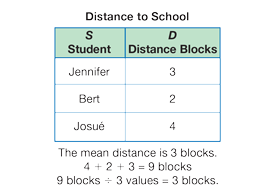Students review how to use averages and graphs to answer questions about data. Students pose questions for investigation and define variables for study. They find the median and mode (averages) of data sets and use them to answer questions about the data.
Content in this Lesson
- Selecting, collecting, and organizing data to answer a question.
- Naming numerical variables to study [E1].
- Making a bar graph [E4].
- Finding the median of a data set [E5].
- Finding the mode of a data set [E6].
- Reading a table or bar graph to find information about a data set [E7].
- Modeling real-world situations with bar graphs [E8].
- Making predictions and generalizations about a data set using a data table, graph, median, and mode [E9, 10].
Daily Practice and Problems G–J
Assessment in this Lesson
| Assessment | Expectation Assessed | Math Practices Expectation Assessed |
|---|---|---|
|
Using Averages to Answer Questions |
|
|















